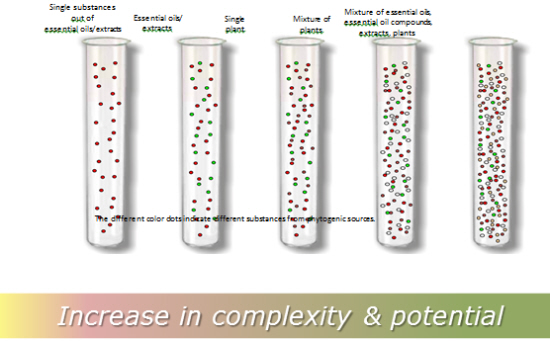



Phytogenic Feed Additives (PFA) in Pig Production
GLOBAL - In praxis feed producers or farmers find themselves confronted with an unprecedented number of products with widely varying composition and claimed effects.
Brief Introduction in Phytogenics
Graphic 1 shows some basic differences in the formulation of Phytogenic Feed Additives (PFA).
Randolf Nott, German pioneer of complex PFA, who launched the 1st generation of the Digestarom®- product line in 1989, stated once: “The fine art of formulating Phytogenics lies in a suitable combination of the right plant materials. It is a very thin line between a successful formula and a mere mixture of different components. A combination of different plant materials, including herbs and spices in complete and finely ground form, essential oils and non-volatile extracts, maximizes the full potential that these plants offer (synergistic effects of the active constituents).”

Graphic 1: Differences in the formulation of Phytogenic Feed Additives
This means that only based on these principles PFA can be developed that are consistent in their effects under a wide range of production conditions.
Navigating through different websites of PFA-producers I always remember the statement of
Prof. O. Simon (Free University of Berlin, Germany) in a symposium held in 2009, after he had given a review about publications, many of them contradictory, regarding Phytogenics: “These examples demonstrate the actual difficulty to assess conclusively the effectiveness of phytogenic compounds used as feed additives with regard to intestinal functions and improved performance. Additional difficulty arises from the fact that most properties were studied in vitro and because of the natural variability in composition of plant secondary metabolites, depending on botanical origin, processing and composition of the plant from which the compound is derived.”
But even more, too many claims made about product effects are lacking in proof, in terms of scientific and field trials. Too many of these claims are imprecise in their statements. Only one example: antimicrobial properties are stated for a wide range of PFA. But no differentiation is made between bactericidal (bacteria-killing) and bacteriostatic (inhibition of growth and reproduction) mode of action. Bactericidal activity bears the risk of developing resistance. This is generally recognized for synthetic antibiotics (most of them chemically synthetized according to mother nature´s blueprint) - but denied for “natural antibiotics”…….? Bacteriostatic effects do not bear this risk.
Which mode of action would you prefer?
Phytogenic Feed Additives – what for?
In the beginning of PFA products there was some confusion regarding the aim of using these products mainly due to inaccuracies when talking about their capability to replace antibiotics. Many scientists stated that PFA cannot replace antibiotics, while others stated that they can. The origin of this dispute simply was that instead of using the correct term “antibiotic growth promoters (AGP)”, often only the term “antibiotics” was used.
Nowadays in science there is no real discussion whether Phytogenics can replace AGP or not. It is commonly accepted that they can and that they have a much wider range of positive effects on the animal than AGP ever had.
Niewold (2007) claimed, that effective growth promoters had to be inhibitors of the intestinal inflammatory response, because inflammation whether it results from either feed or disease
is inversely related to growth and health.
In human medicine the influence of plant extracts on inflammatory processes has been investigated for many years. Similar investigations were made recently with Digestarom® at the University of Giessen (Germany) and it was found that this product reduced the inflammatory response in epithelial cells. The same investigation showed that this particular complex PFA, contrary to another investigated phytogenic product, stimulated intracellular defense mechanisms.
Furthermore, complex PFA exert flavoring properties as equivalent to conventional flavors.
A multitude of essential live-processes can be influenced by Phytogenics. To mention only some of them:
- Stimulating endogenous secretions is one of the most important effects of Phytogenics, hence improving digestibility of nutrients, especially protein and most amino acids (Maenner et al., 2011); modulating gut micro-biota, stabilizing gut health and functionality.
- PFA can also exert positive effects on liver function, stomach and gut motility and a multitude of other body functions.
In summary, only based on a holistic approach including the animal itself and the economical and ecological circumstances of animal production, consistently effective and therefore successful (for user and producer) PFA can be formulated.
Phytogenics like Digestarom® can help the animal to protect itself (prophylactic and overall stabilizing properties), to exploit better available nutrients (feed intake and digestibility enhancement), to improve its performance and last but not least to obtain a more economical and more environmentally-friendly production.








